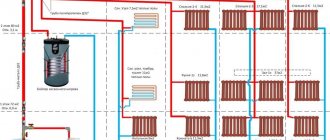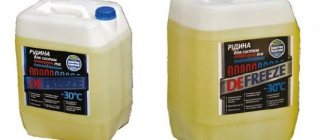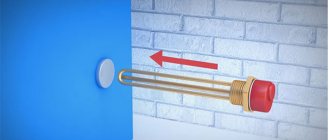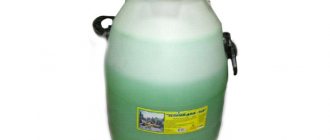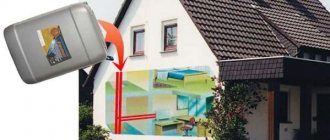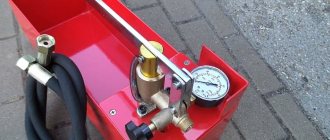Residents of multi-apartment buildings rarely encounter heating problems, since they are connected to a central system and do not think about whether to heat the house with wood, gas or electricity. But in private homes it is necessary to install boiler rooms, the financial costs of using and installing which can be reduced through the use of electric heating boilers. Thanks to it, the efficiency improves. Also, the water supply becomes uninterrupted, while its volumes increase.
The most economical electric boiler is a myth
Electricity is much easier to convert into heat than other energy sources - natural gas, solid fuel, diesel fuel. Here are 3 simple examples of heat by-products when using electricity:
- the windings of any operating electric motor always heat up;
- a light bulb (even an LED one) produces heat along with the light;
- Even the wires through which current flows become heated.
Please note that the equipment listed is designed to perform its functions, and not to heat the house. The motor rotates something, the lamp shines, the wiring supplies them with energy. The formation of excess heat is a side effect that occurs due to the resistance of these elements.
Spiral and induction heater converting electricity into heat with 99% efficiency
To convert all electrical energy into thermal energy, it is enough to create a high resistance section in the circuit, which itself will not collapse from heating. This element is called an electric heater. The second (more complex) way to obtain heat is to create Foucault induction eddy currents that heat a metal object in the area of action of the inductor coil.
Important point. Regardless of the conversion method, 98–99% of electricity will turn into heat. That is, any electric heating device operates with an efficiency of 98–99%, no less. This means that the most economical electric boiler does not exist; all units are equally efficient. No matter what home appliance sellers claim.
Features of the electric boiler
The main design elements of an electric heating boiler are a tank and a heating element. The devices are equipped with monitoring and automatic control systems.
Various models may also include expansion tanks and circulation pumps.
When purchasing a boiler, you should pay attention to the type of electric heating element. Over time, lime particles settle on the heating elements, which affects the power of the device
Electric boilers have several advantages:
- Fire safety . Thanks to automatic control systems and the absence of open flames, the devices are safe. They do not emit toxic substances or combustion products and are not capable of exploding.
- Ease of installation. Electrical equipment requires no flue or ventilation, making installation easy.
- High efficiency . Regardless of the type of heating device, all electric boilers are highly efficient.
- Compactness . Electrical appliances, especially wall-mounted ones, take up little space.
- Nice design . Most modern models are stylistically versatile and look good in the interior.
Electric boilers are almost ideal - easy to use and safe. Their only serious drawback is the high cost of electricity. One more nuance: for residents of regions where there are frequent interruptions in the power grid, it is better to choose boilers that operate from other energy sources, or take care of purchasing additional heating devices.
Advantages and disadvantages of heating with an electric boiler
The main advantage of the scheme is simplicity. Almost any craftsman can assemble such a structure, since for this purpose neither special qualifications nor complex tools are required. Another advantage is the low price. Most often, electric water heaters for heating are sold at lower prices than electric boilers. Thanks to this, when creating a heat supply system for small objects, you can save significantly. In this case, you can get a very reliable, highly functional system that can be controlled via modern communication lines, for example, Wi-Fi. That is why it integrates well into the Smart Home program.
The disadvantages of using water heaters include:
- Low power.
- The heating element is constantly in working condition, which leads to rapid wear. To guarantee, you need to choose devices with 2 or more heating elements.
How does an electric water heater for heating work?
As a rule, such devices are used exclusively for hot water supply. But modern technologies make it possible to use it as an additional thermal circuit for heating water in a heating system. Before using the water heater to prepare the coolant for heating devices, it is necessary to modernize its recharge circuit:
Create a forced coolant circulation circuit.
It is necessary to connect the heating circuit with the installation of protection and control devices: an expansion tank, a circulation pump and shut-off and control valves, a control and protection unit with primary sensors for temperature and pressure of the medium.
The originality of the idea, and its practical implementation, lies in the synchronous operation of the same source: for hot water supply and heating. For this reason, it is recommended to first select an electric pump of the required electrical power. It must be able to cover all hydraulic losses in the system and evenly distribute heat throughout the heating devices. Experts recommend installing water purification filters at the inlet in front of the boiler in simultaneous hot water and heating systems.
Method of heating water with a water heater
Modern electric water heaters for heating operate on the same principle as boilers. A large sealed container is filled with water, which is heated using electric heating elements. In this case, heat loss occurs through the housing.
In boilers, the coolant increases the temperature when passing through a heat exchanger with a built-in heating element. Since the volume of this chamber is relatively small, heating occurs quickly. At the same time, heat losses are minimal. It should also be noted that in most cases the design already includes a circulation pump, an expansion tank and a convenient control system. Apart from the latter, electric water heaters for heating of the VEO type do not have these elements.
Storage tank and heating boiler
The storage tank is ultimately completely identical to a classic water heater. The difference lies in the internal coil, which is connected to the heating system.
We recommend: Gas heaters for tents - how to choose, review of the best models, prices and reviews, where to buy
A professionally organized heat supply system through a heat exchanger implies that this component will act as a thermal accumulator. The liquid medium in the tank receives heat through a coil heat exchanger connected to the in-house heating pipe system.
Indirect heating boiler
The optimal alternative for heating small rooms is to include an indirect heating boiler in the heat supply scheme. They can be universal, capable of operating on different types of energy carriers: gas, flue gases from the combustion of solid fuels and electricity.
Typically, such devices are installed in heat supply circuits to increase overall efficiency in the form of an additional heating source. The main one is the traditional heating boiler. For efficient operation of an indirect heating water heater, it must be installed before entering return network water into the boiler unit. In this way it is possible to create an optimal heating system.
Heating via boiler
A water heater is an electric heating device, originally produced for hot water supply. It is made in the form of a container, with an internal arrangement of a thermal electric heating element - heating element. There are designs in which a group of heating elements from 2 to 3 is installed. In order to understand whether such a device is capable of serving as a source of heating for a house, it is necessary to consider the fundamental differences between a heating boiler and an electric boiler.
In the first option, when water is heated, its natural circulation is carried out; for this purpose, appropriate inputs are made. The boiler unit receives cooled return water from heating appliances in the upper part of the structure, and is discharged through the supply pipes from below. The boiler for heating a private house is structurally designed in such a way that both pipes are located on the same side and this does not allow the coolant to move according to the principle of natural circulation. Therefore, it is fundamentally important to connect the heating boiler in such a system using a circulation pump, which will ensure forced movement of water along the circuit.
Heating inertia
The rate of increase in water temperature in pipes for electric boilers is quite high. The average heating time from 25 degrees to 60 degrees is 15-20 minutes, depending on the volume of the system. In this regard, heating using a water heater is significantly inferior to traditional heating. In order for the volume of water in a boiler with a capacity of 150 liters to reach the desired temperature, you need to wait about an hour. The main criteria influencing this indicator are the power of heating elements, the volume of the tank and the entire system as a whole.
However, when the electric boiler stops working, the water in the pipes quickly cools down. At the same time, in a water heater system, a large volume of hot liquid is in the tank and will require several circulation cycles for it to cool. Those. In the event of an unexpected power outage, the coolant in the boiler system will remain hot for some time.
Summarizing these factors, we can determine the main conditions for using an electric water heater for heating:
- The area of the heated room should be relatively small. This is due to the ratio of 1 kW of thermal energy per 10 sq.m.;
- Good quality running water to preserve all heating elements;
- To fill the tank, it is necessary to create the same pressure as in the water supply - 4 atm. This applies only to those cases when a regular boiler is installed that is not intended for heating from a water heater. In specialized models, the minimum pressure value is much lower - from 1.5 atm.
You can use an electric water heater to heat a house with a small area of up to 80 square meters. First of all, this applies to country houses.
The second way to use an instantaneous water heater for heating is to install a heated floor system. But even in this case, you must carefully read the diagram for connecting the device to the pipeline.
Review of water heaters for electric heating
Manufacturers of heating devices already produce conventional boilers, adapted for installation in heat supply networks. Their thermal power has been increased to 12 kW, in addition, they have increased input diameters for connection to the in-house heating system.
Heating from a boiler is not difficult to implement. Since such equipment is widely represented on the market, both domestic and foreign manufacturers. Their choice will depend on the required type of energy carrier and the type of heating: capacitive or indirect heating. The latter are more used in autonomous heat supply schemes, so the principle applies here - the more, the better. They are well used during the heating season, and
In summer, for hot water supply, it is wiser to use combined water heaters.
The most popular models of water heaters that are used in heating systems:
- Heating boiler Thermex Champion Titaniumheat 150 V, made in Russia, heating element, volume 150 l, price - 12,190 rubles.
- Water heater for heating Gorenje TGU150NGB6, made in Serbia, heating element, volume 150 l, price - 14,320 rubles.
- Ariston ABS PRO R 150 V, made in Russia, heating element, volume 150 l, price – 14970 rub.
- Bosch WSTB 200, made in Germany, indirect heating, volume 197 l, price - 40,833 rubles.
- Baxi Premier plus 150 (30 kW), made in Italy, indirect heating, volume 150 l, stainless steel tank price - 68,600 rubles.
- Buderus Logalux SU160/5 made in Germany, indirect heating “coil in coil”, stainless steel DUPLEX, volume 160 l, price - 68869 rub.
Selection of heat generator by power
To select the power of an electric boiler, first of all, calculate the heat losses of your home. You probably know the approximate method of calculation: to heat 100 square meters of building area, a heating unit with a capacity of 10 kW is taken, for 200 m² - 20 kW, and so on. If you want to get a more reasonable result, use our calculation methods.
A very approximate calculation method - we divide the area of all rooms by 10, we get heat loss in kilowatts
Now let’s define the tasks that an electric boiler must solve (select the desired list item):
- round-the-clock heating of an apartment, cottage, country house;
- the same, with water heating for domestic needs;
- work at night at a cheap rate;
- standby heating – maintaining the air temperature +5…10 °C.
Note. Night heating of the house with an electric boiler can be combined with heating of the heat accumulator. At 7.00 the unit turns off, then the water system receives the heat accumulated in the buffer tank. 2 conditions: the allocated limit for electricity consumption must be 15...20 kW + powerful electric boiler.
Full heating with electricity is not cheap and is used as needed. A more profitable option is night heating from 23.00 pm to 7.00 am, when the cost of energy is half as much. The standby mode is used on objects under construction or dachas, where the owners spend 2-3 days weekly.
We select the power of the electric heating boiler depending on the tasks:
- For round-the-clock operation, the unit is selected with a margin of 10...20%. That is, the heat loss figure is multiplied by a factor of 1.1–1.2. For example, a house with an area of 60 square meters loses 4 kW, the productivity of the electric boiler will be 4 x 1.2 = 4.8 kW.
- For hot water supply (DHW), the power of the unit should be increased by 50%. That is, multiply the figure 4 kW from the example by a factor of 1.5 (we get 6 kW).
To obtain hot water, it is customary to connect a single-circuit electric boiler to an indirect heating boiler through a three-way valve. The latter switches the coolant between the tank and the heating system - An electric heating device for night heating can be taken without a power reserve if it is replaced in the morning by a gas or solid fuel boiler. Reducing the temperature to 18–19 °C during sleep will not cause much discomfort, but will save money.
- The power of the electric boiler that maintains positive temperatures in the building is taken with a reduction factor of 0.6–0.7 (minus 30–40%) of the amount of heat loss.
Advice. To organize DHW, you do not need to look for a double-circuit boiler. Usually there are 2 options: installing a separate electric water heater or a powerful heat generator plus an indirect heating boiler.
The performance of the heater for nightly “charging” of the heat accumulator depends on the volume of the tank and is calculated individually. The selection of an electric boiler under standard conditions is described in the video:
Which water heater is better: instantaneous or storage?
Deciding which water heater to buy - a boiler (storage) or a flow tank - is, in principle, not difficult. First of all, the limiting factor is the power consumption: for storage water heaters the maximum is 3-4 kW, for instantaneous water heaters it is pointless to take less than 7-8 kW - they can only heat a very small volume of water. Not everyone has the opportunity to install such powerful equipment.
Secondly, you need to look at whether you will use the electric water heater constantly or only periodically. For periodic use, especially in summer, instantaneous water heaters are convenient, even of the open type (individual, which are installed next to the sink). For example, this is a great way to heat the water in a summer shower at the dacha to a comfortable temperature if the sun cannot cope with this task. This is also a way to solve problems in apartments when the hot water supply is turned off for repairs.
For constant and regular use, storage water heaters are more economical and convenient. Modern models “keep” the temperature for more than a day, so the electricity consumption here will be less rather than more.
Types of devices
When choosing a boiler for heating, many are interested in its two parameters. The first is the volume of the tank, the second is the electrical energy consumed.
Instantaneous water heater
A flow-through water heating boiler does not have a container designed for a large volume. It is designed so that the water consumed is heated instantly. There are two types used in everyday life:
- Electric - production takes place in a compact case, wall mounting. Water is heated as it passes through an electric heater.
- Gas - water flows inside the heat exchanger. A gas burner burns under it, which heats the liquid.
We recommend: Flushing the heat exchanger of a gas boiler: nuances of the procedure and review of cleaning products
An instantaneous electric water heater intended for heating has the following device:
- Body - the material is metal or plastic, the outside is covered with a special coating for protection and decoration.
- Heat transfer tube - located inside the housing, most often has a spiral shape.
- The heating part is located in the heat exchange tube or in a separate metal glass.
- Flow meter - there is a reaction to the closing/opening of the faucet mixer.
- Electromagnetic starter - controls a magnetic starter and is a powerful electric heater.
- Thermostat - turns the unit on/off, regulates the supply of hot water based on the pressure power.
- Thermal fuse - necessary for emergency shutdown of the device.
| pros | Minuses |
| Light weight, compact parameters | Due to their complex manufacturing, their price is quite high. |
| It is possible to operate immediately as soon as it is turned on, since the water heats up quickly | High electricity consumption |
| Connection and installation can be done independently in an hour and a half | To connect, it becomes necessary to lay another network cable separately |
| All parts inside are made of metal that is not subject to corrosion |
Electric storage boiler
Electric storage boilers are most often used in everyday life. Externally they have differences, but the device itself is the same:
- The case is made of steel with a thickness of 0.8 millimeters. A polyester enamel coating is applied on top, serving not only as decoration, but also as protection.
- The tank is located inside the body, made of steel 1.2 millimeters thick, the outside is coated with corrosion protection. It has three types. The first is a heat-strengthened coating, used in inexpensive models. It is considered not particularly durable: the enamel can crack and crumble due to a sharp change in temperature. The second is glass ceramics, applied at high temperatures, very durable. The third is titanium coating, the most durable and strong, used on expensive models.
- Thermal insulation - minimum thickness is 20 millimeters, maximum - 40. It looks like a layer between the tank and the outer casing.
- Magnesium anode - designed to protect against rust. Installation takes place near the heating element and protects the tank and heating part from electromechanical corrosion.
- Heating element - located at the bottom of the tank.
- Thermometer - digital or mechanical. Located outside the housing, designed to control water.
- Thermostat - automatically turns on/off the heating element. Adjustment is manual or electronic.
- Indicator LED - connected to the thermostat, lets you know when the heating element is on or off.
- Water pipes are made of metal, end with a thread on the outside, and are connected to the water supply.
- Mounting Bracket - Used to mount the unit to the wall.
| pros | Minuses |
| A large assortment | Installation should only be carried out on a solid wall due to the heavy weight of the devices |
| Installation is simple, easy, completed in a couple of hours | Maximum service life is nine years, as corrosion resistance is reduced |
| Part replacement takes a maximum of one and a half hours | Due to the insulation, the parameters are quite dimensional |
| Low electricity consumption | Takes a long time to heat up (from half an hour to nine hours) |
| A thick layer of scale appears |
Classification
Electric boilers are divided into three main types:
- heating elements;
- electrode;
- induction
In addition, there are a number of other differences between them. For example, there are floor or wall models. They can be connected to 380V or 220V - depending on the size of the room (used for a private house or small apartment). Also the main indicator is the number of circuits in which hot water is located - one or two.
heating elements new
An electric boiler operates based on the process of converting current into thermal energy through the use of tubular heaters installed directly in the tank. The heating element raises the temperature of the liquid inside the pipe. When it enters the heating system, it warms up the room.
To ensure that the device always works as required, a control unit is provided. The heating is controlled by a room temperature controller. It is he who perceives a decrease in this indicator and reports the need to increase heating. The required pressure appears as a result of connecting the pump. Thanks to the use of modern technologies, after the room temperature rises to the set point, the mode is turned off. After some time, the pump that moves the coolant also stops working.
The main advantage of this type of boiler is the absence of contact between the liquid and the heat exchanger. This allows the use of protective devices for automatic shutdown.
The equipment makes it possible to simply implement smooth or step control.
Like any other devices, these have their drawbacks. Heating element boilers have a limited service life compared to other boilers. Premature burnout due to improper use cannot be ruled out. Before purchasing, be sure to pay attention to the possibility of repair or replacement.
Also, scale quickly forms on the tubular heater itself. This significantly reduces the service life of the device. It is imperative to artificially reduce the hardness of the liquid.
Such water heating boilers are single- and double-circuit units. The latter provide hot water supply and heating.
In most cases, installations are hung on the wall, although there are also those that are located on a flat, hard surface.
This type is considered the most popular among electric boilers.
Electrode
Heating of the coolant is carried out by direct passage of current through it. In this case, there are no “intermediaries” in the form of heating elements. Electrolysis does not occur since the anode and cathode are constantly changing places.
It is important to note that if operated without liquid, the electric heating or hot water boiler will not fail. In addition, scale does not destroy the electrodes - sometimes a slight decrease in power is observed.
The coolant temperature increases quickly. This increases the pressure with which water moves through the network - there is no need to install a pump. Perfect for the bathroom as it doesn't take up much space.
We recommend: Water in-floor heating convectors: their types and characteristics
Such a water unit has an efficiency of about 96%. At the same time, it is durable and reliable in use.
Such a device cannot be connected through a protection element. Only special antifreeze is used as a coolant.
Induction
Such installations have a design similar to a transformer consisting of two circuits. The primary is the magnetic system, and the secondary is the heat exchange device. By means of an alternating field, electricity allows the coolant to be heated.
The main advantages include safety, as well as interaction with various heating fluids. Like the previous option, it is well suited for the bathroom.
But there are also disadvantages. The main ones are the initial price, as well as the cost of subsequent operation.
Boilers
It is worth mentioning electrical storage installations. In fact, they are heating elements equipment installed in parallel. In this case, they can be intended either separately for hot water supply or heating, or for both directions. For the latter, indirect heating systems are used. Such storage electrical installations make it possible to raise the temperature of water for household needs with coolant intended for heating.
This boiler is ideal for use in country houses. It is mainly installed together with boilers that use any energy source. At the same time, it is barely warm on the outside, since usually such installations have high-quality protection that allows energy to be stored inside for a long time.
Water heating: heating element type boilers
Electric water heating is considered more efficient than using only simple heating electrical appliances. This heating system uses ordinary water as a coolant. To heat the water to the required temperature, the system is equipped with a device such as a boiler or electric boiler. Domestic boilers, which are used to heat water, are not suitable as the main device of a water electric heating system. The boiler, which is necessary for the efficient operation of the heating system, must have much higher power ratings. To organize an autonomous electric heating system, a wide variety of installations can be used, such as:
- Heating element installations;
- Induction installations;
- Electrode installations.
The most popular are heating element boilers, which can be seen in the photo. The operating principle of such boilers is as follows: the coolant enters the internal tank of such boilers. A heating element is placed in the tank, which will begin to heat up, and its temperature will be transferred to the coolant. Thanks to the circulation pump, the coolant will flow into the heating circuit and then distribute through the final consumption elements, that is, to the heating radiators.
Electric boiler
It must be remembered that the most vulnerable point of the boiler is the heating element. It is necessary to choose a boiler in which the heating element is a replaceable component. The heating element may fail in a few years, as it will become covered with scale, and then it will need to be replaced. Most boilers are equipped with automation, which allows you to turn on a certain operating mode. This allows you to significantly save on electricity, since the boiler will heat the water only when it is needed.
Another advantage that electric water heating provides is the fact that the electrical components do not come into contact with water at all. In the event of an accident, the automation will completely turn off the heating element.
Heating a house with electricity
General positive aspects
Generally speaking, all electric boilers, regardless of type, have a number of advantages:
- ease of execution;
- there is no need to separately create a place for installing equipment;
- no need to think about purchasing, delivering and storing energy;
- there is no need to remove the chimney;
- safety, because there is no possibility of leakage of toxic substances;
- environmental friendliness - no harmful emissions.
If you install electric double-circuit water heating units, connecting all its functions, the consumer will not experience any problems with heating the room or supplying water at the required temperature for household needs.
Method of heating water with a water heater
In terms of the method of increasing the temperature of the energy carrier, a flow device does not differ from a storage boiler. The sealed tank is filled with liquid from a centralized water supply. Electric heating elements increase the temperature to a given level. Units of 2 types are characterized by some loss of thermal energy.
Diagram of water heating by the device.
In a storage boiler, the temperature of the liquid rises inside a sealed container with an integrated heater. Since the volume of the chamber is small, the process proceeds rapidly and with little heat loss. The design of such units includes:
- Electric pump.
- Storage tank.
- Mechanism for controlling water supply and heating temperature.
Flow units lack the first 2 components.
The nuances of choosing the right model
Electricity is an expensive energy resource. If the boiler is selected incorrectly, you will have to pay huge electricity bills.
Therefore, it makes sense to pay attention to some nuances:
- functions . It is necessary to decide what functions the boiler should perform - only heat the house or additionally supply it with hot water.
- Technical parameters of the boiler. Be sure to take into account not only the heated area, but also the degree of its thermal insulation.
- Price . In many ways, the cost of heating devices depends on power, but that’s not all. Additional features can lead to a significant increase in the price of the model. Therefore, you need to clearly understand whether your budget allows you to overpay for convenience.
Even before you start looking for a boiler, you should find out how powerful it should be.
You can calculate the power based on average indicators: 1 kW of electricity is enough to heat a room of 10 square meters. with a ceiling height of up to 3 m. It turns out that a device with a power of 6 kW or more is suitable for heating a small house with an area of 60 m2.
When purchasing an electric boiler, energy consumption is of fundamental importance. It’s better to overpay for a more expensive model, but save on its operation
It is advisable to take into account the degree of thermal insulation and buy a boiler with a small power reserve (20%). If the house is poorly insulated, it is better to choose a gas or solid fuel model, since heating with electricity will be too expensive.
What will help you save on heating?
There are several devices that help reduce energy consumption and reduce the cost of heating a home:
- Thermostats . Heating boilers equipped with thermostats do not overheat the rooms, but at the same time maintain the set temperature.
- Programmers . “Smart” boilers regulate the room temperature according to a specific schedule. Although the boiler itself is constantly running, the heating element consumes electricity only 34% of the time. Read more about installing a heating system in a smart home here.
- Multi-stage power regulators . Thanks to automatic regulators, energy resources can be used extremely rationally.
- Microprocessors . The devices smoothly regulate the power of boilers, and some devices can even be controlled remotely - from smartphones or other gadgets. Such models are expensive, but worth the money spent.
The energy consumption of an electric boiler is significantly affected by the presence or absence of a circulation pump.
If it is not included in the model, it is advisable to purchase it separately and connect it to the heating system.
If there is a possibility that the house will be left for some time during the cold season, it is better to choose a model with a coolant freeze protection system
When purchasing a boiler for a country house or cottage, you should pay attention to antifreeze protection systems for the coolant.
Installation and selection of coolant for a water heater
Installed water heater in the boiler room
Before turning the water heater into heating, it is necessary to calculate the optimal power. In this case, you cannot be guided by the rated power of the installation. The main indicator is the time it takes to heat the water to the desired temperature. In some models it is limited to 20-30 minutes, but for most it is more than an hour.
When using a conventional electric water heater to heat your home, we recommend using the following tips.
- Installation of the unit should be carried out in a warm and dry room. In this way, heat losses can be minimized;
- The electrical wiring must be designed for the maximum load of the water heater from the home heating system;
- It is recommended to use simple distilled water as a coolant. Compared to antifreeze, it has better heat capacity;
- It is best to purchase models with a closed heating element. This will prevent scale from forming on the heating elements.
According to most experts, the optimal choice is electric water heaters for heating of the VEO type. It is important to choose the right model of a certain power. In this case, it is necessary to take into account the parameters of the main heating boiler. Together they should form an optimal air heating system in the house.
The video shows an example of self-installation of a conventional boiler as the main heating device.





